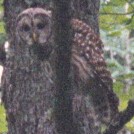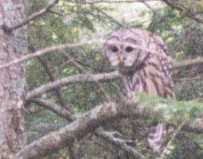BREEDING SYSTEM:
- Where Breeds: Breeds in woodlands or wooded swamps.
- Nest: The nest is found in a natural cavity in tree trunk or stub, or in the nest of a hawk or an old squirrel nest or in a nest-box, and is 15-30 ft. high (Baicicich and Harrison, 1997). The nest is in an unlined cavity (Baicicich and Harrison, 1997).
- Breeding Season: The breeding season begins in late December in the south of its range to mid-March in the north of its range (Baicicich and Harrison, 1997). This species is single-brooded, but will replace a lost clutch (Baicicich and Harrison, 1997).
- Eggs: There are between 2 and 3 eggs laid in a clutch (Baicicich and Harrison, 1997). The eggs are elliptical or almost spherical to short subelliptical in shape and white in color (Baicicich and Harrison, 1997). The average size of an egg is 49 X 42 mm (Baicicich and Harrison, 1997).
- Incubation: The incubation period is from 28 to 33 days and is done by the female (Baicicich and Harrison, 1997).
- Nestling: The young are born altricial and downy, with down being thick, soft, and white (Baicicich and Harrison, 1997). A second downy coat is buffy and white in color (Baicicich and Harrison, 1997). The young fledge from the nest after 4 to 5 weeks, and they can fly after 6 weeks (Baicicich and Harrison, 1997). They are cared for four months after they leave the nest by their parents (Baicicich and Harrison, 1997).
|
 |







